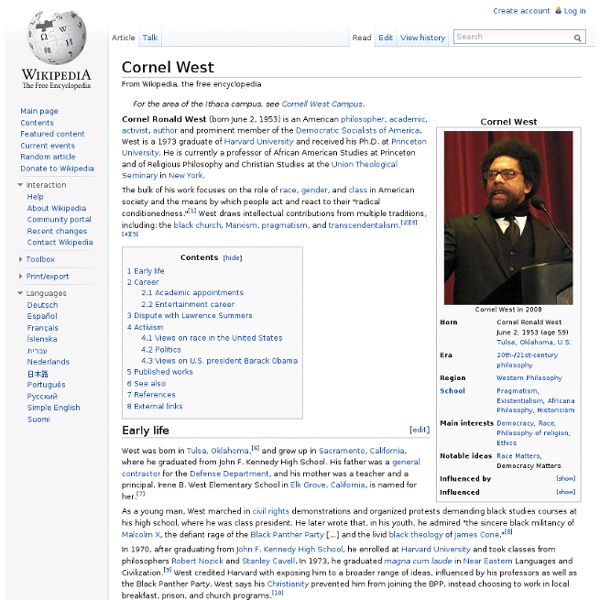



Center for African American Studies We thank the supportive and generous Princeton University alumni who recognize the important work of the Center for African American Studies. On March 11, we dedicated the Hobson-Rogers Seminar Room and the Barfield-Johnson Seminar Room of Stanhope Hall, our historic home. Professor Naomi Murakawa joins the faculty at the Center for African American Studies as an associate professor of African American Studies. AAS 353/ENG 352 (LA) African American Literature: Origins to 1910 Fulfills AAS certificate core survey pre-20th century course requirement Lecture L01: 11:00 am – 11:50 am TTh Christopher M. In addition to taking AAS 201, which was offered this fall, undergraduates seeking a certificate in African American studies must take five additional courses or seminars either originating in the center, or formally cross-listed by it.
Rigoberta Menchú Rigoberta Menchú Tum (Spanish pronunciation: [riɣoˈβerta menˈtʃu], born 9 January 1959) is an indigenous Guatemalan woman, of the K'iche' ethnic group. Menchú has dedicated her life to publicizing the plight of Guatemala's indigenous peoples during and after the Guatemalan Civil War (1960–1996), and to promoting indigenous rights in the country. She received the 1992 Nobel Peace Prize and Prince of Asturias Award in 1998. She is the subject of the testimonial biography I, Rigoberta Menchú (1983) and the author of the autobiographical work, Crossing Borders. Menchú is a UNESCO Goodwill Ambassador. Life[edit] Rigoberta Menchú was born to a poor indigenous family of K'iche' descent near Laj Chimel, a small town in the north-central Guatemalan province of El Quiché. Since the Guatemalan Civil War ended, Menchú has campaigned to have members of the Guatemalan political and military establishment tried in Spanish courts. Politics[edit] In 2009 she was involved in the newly founded party Winaq.
Brief Answers to Cosmic Questions Structure of the Universe Does the Universe have an edge, beyond which there is nothing? Are the galaxies arranged on the surface of a sphere? Why can't we see the whole universe? Does the term "universe" refer to space, or to the matter in it, or to both? Evolution of the Universe Did the Universe expand from a point? More about the Big Bang When they say "the universe is expanding," what exactly is expanding? Structure of the Universe Does the Universe have an edge, beyond which there is nothing? Are the galaxies arranged on the surface of a sphere? Why can't we see the whole universe? If you could suddenly freeze time everywhere in the universe, and magically survey all of creation, you would find galaxies extending out far beyond what we can see today. Does the term "universe" refer to space, or to the matter in it, or to both? Today, the situation is reversed. Discovering the properties of space remains one of the deepest and most important problems in modern science.
Asmaa Mahfouz Asmaa Mahfouz (Arabic: أسماء محفوظ, pronounced [ʔæsˈmæːʔ mɑħˈfuːz, ˈʔæsmæ-], born 1 February 1985) is an Egyptian activist and one of the founders of the April 6 Youth Movement.[1] She has been credited by journalist Mona Eltahawy and others with helping to spark mass uprising through her video blog posted one week before the start of the 2011 Egyptian revolution.[2][3] She is a prominent member of Egypt's Coalition of the Youth of the Revolution and one of the leaders of the Egyptian revolution.[4] In 2011, she was one of five recipients of the "Sakharov Prize for Freedom of Thought" awarded for contributions to "historic changes in the Arab world." The other joint recipients were Ahmed al-Senussi, Razan Zaitouneh, Ali Farzat and Mohamed Bouazizi of the Arab Spring. Arabian Business placed Mahfouz at #381 on its list of the World's 500 Most Influential Arabs.[5] Overview[edit] January 2011 uprising in Egypt[edit] If you think yourself a man, come with me on 25 January. See also[edit]
Top 10 Universities With Free Courses Online #1 UC Berkeley Ranked as the #1 public school in the United States, Berkeley offers podcasts and webcasts of amazing professors lecturing. Each course has an RSS feed so you can track each new lecture. For printable assignments and notes you can check the professors homepage, which is usually given in the first lecture or google his name. Even though the notes, homework and tests are not directly printed in the berkeley website, as they are in MIT and other courseware sites, it's not a problem to find them. I personally tried to use it for John Wawrzynek's machine structures class and the nutrition courses. Visit:Berkeley WebcastsVisit:Berkeley RSS FeedsVisit:UC Berkeley on Google Video Getting The Most From Berkeley Webcasts Berkeley Videos are in .rm format and real player can be a pain. Download:Real Alternative PluginDownload:Media Player Classic For Windows XP/2000Download:Media Player Classic For Windows 98/ME #2 MIT Open Courseware Getting the Most Out of MIT OCW Download:Foxit Reader
Subcomandante Marcos Subcomandante Marcos or Subcomandante Insurgente Marcos is the nom de guerre used by the main ideologist, spokesperson and de facto leader of the Zapatista Army of National Liberation (EZLN), a Mexican rebel movement fighting for the rights of the indigenous peoples of Mexico. On 1 January 1994, when the U.S.–Mexico–Canada free trade agreement became effective, Subcommander Marcos led an army of Mayan farmers into eastern Chiapas state, to protest what he saw as the Mexican federal government's mistreatment of the nation's indigenous peoples.[1] Marcos is also a writer, a political poet, and an anti-capitalist who advocates the amendment of the Political Constitution of Mexico to formally and specifically recognize the political and the human rights of Mexico's indigenous peoples.[2] Background[edit] Identity[edit] Subcomandante Marcos (center, wearing brown cap) in Chiapas In an interview with García Márquez and Roberto Pombo, Marcos spoke of his upbringing: "It was middle class.
Nick Bostrom's Home Page Poor People's Campaign